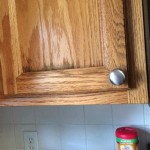How To Change The Color Of Stain On Your Kitchen Cabinets
Changing the color of stain on kitchen cabinets can significantly alter the overall aesthetic of a kitchen. It is a cost-effective alternative to replacing the entire cabinetry and allows for a customized look. However, the process requires careful planning, preparation, and execution to achieve a professional and lasting finish. This article details the steps involved in successfully changing the stain color of kitchen cabinets, including the necessary materials, techniques, and considerations.
Assessing the Existing Finish and Wood Type
Before embarking on the project, a thorough evaluation of the existing cabinet finish and wood type is crucial. Understanding these factors will determine the appropriate methods and products to use. The existing finish can be broadly categorized as either a surface finish (like varnish, lacquer, or polyurethane) or a penetrating finish (like stain or oil). A surface finish creates a protective layer on top of the wood, while a penetrating finish soaks into the wood fibers. Determining which type is present will influence the preparation steps required.
To identify the existing finish, perform a simple test. Dampen a clean cloth with denatured alcohol and rub it on an inconspicuous area of the cabinet. If the finish becomes sticky or softens, it is likely a lacquer or varnish. If the finish remains unaffected, it is probably a more durable finish like polyurethane or a penetrating stain with a topcoat. Knowing this will determine the aggressiveness of sanding or chemical stripping needed.
The type of wood used for the cabinets also matters. Hardwoods like oak, maple, and cherry have tighter grain patterns and generally accept stain evenly. Softwoods like pine and fir have more open grain patterns and may require a wood conditioner to prevent blotchy staining. Identifying the wood type will help in selecting the right stain and application techniques.
Consider the desired final color in relation to the existing stain color. Changing from a dark stain to a lighter stain is inherently more challenging than darkening the existing finish. Removing dark stain completely to achieve a light finish often requires extensive sanding or the use of chemical strippers, which can be time-consuming and labor-intensive. If transitioning to a lighter color is the goal, carefully assess the feasibility and consider whether painting might be a more practical option.
Preparation: Stripping the Existing Finish
Proper preparation is paramount to achieving a successful stain color transformation. This typically involves removing the existing finish, which can be accomplished through either sanding or chemical stripping, or a combination of both. The choice depends on the type of existing finish, the complexity of the cabinet design, and personal preference.
Sanding involves using abrasive materials to mechanically remove the finish. Start with a coarser grit sandpaper (e.g., 80-grit) to remove the bulk of the finish, then gradually progress to finer grits (e.g., 120-grit, then 220-grit) to smooth the wood surface. Using an orbital sander can expedite the process, particularly on flat surfaces. However, intricate details and moldings may require hand sanding to avoid damaging the wood. When sanding, work with the grain to prevent scratching and ensure a uniform surface.
Chemical stripping involves applying a chemical solvent that softens the existing finish, allowing it to be scraped away. This method is particularly useful for removing multiple layers of finish or for cabinets with intricate carvings that are difficult to sand. Choose a stripper appropriate for the type of finish being removed. Apply the stripper according to the manufacturer's instructions, allowing adequate dwell time for it to penetrate the finish. Use a plastic scraper to gently remove the softened finish, being careful not to gouge the wood. Multiple applications may be necessary to remove all traces of the old finish.
After stripping, whether by sanding or chemical means, thoroughly clean the cabinets to remove any residual dust or stripper residue. Use a tack cloth or a damp cloth with mineral spirits to wipe down all surfaces. Allow the cabinets to dry completely before proceeding to the next step. This ensures that the new stain will adhere properly and provide a uniform color.
Inspect the cabinets for any imperfections, such as dents, scratches, or cracks. Fill these with wood filler, allowing it to dry completely before sanding it smooth. This will create a flawless surface for the new stain.
Staining and Sealing the Cabinets
Once the cabinets are properly prepared, the staining process can begin. Choosing the right stain and applying it correctly are essential for achieving the desired color and a professional-looking finish. Select a stain that is compatible with the wood type and the desired color outcome. Oil-based stains penetrate deeply and offer rich color saturation, while water-based stains are lower in VOCs and dry more quickly. Gel stains are a thicker consistency and are useful for staining vertical surfaces or for achieving a more uniform color on woods with varying grain patterns.
Before applying the stain to the entire cabinet, test it on an inconspicuous area to ensure that the color is as expected. This allows for adjustments to be made before committing to the entire project. Apply the stain evenly using a brush, cloth, or foam applicator. Work with the grain of the wood and avoid applying too much stain, which can result in a blotchy finish. Allow the stain to penetrate for the recommended time according to the manufacturer's instructions. Wipe off the excess stain with a clean cloth, again working with the grain. This will remove any stain that has not been absorbed by the wood and prevent a sticky or uneven finish.
Allow the stain to dry completely, typically for 24-48 hours, depending on the type of stain and the ambient temperature. Once dry, apply a clear topcoat to protect the stained surface and enhance its durability. Polyurethane is a popular choice for kitchen cabinets due to its resistance to moisture, scratches, and stains. Apply the topcoat in thin, even layers, allowing each coat to dry completely before applying the next. Lightly sand between coats with fine-grit sandpaper (e.g., 320-grit) to smooth the surface and improve adhesion.
The number of topcoat layers will depend on the desired level of protection and the sheen of the finish. Typically, two to three coats are sufficient for kitchen cabinets. Allow the final coat to dry completely before reassembling and reinstalling the cabinets. This will ensure that the finish is fully cured and resistant to damage.
Addressing Common Staining Challenges
Despite careful preparation and application, several challenges can arise during the staining process. Understanding these potential issues and knowing how to address them can help ensure a successful outcome.
Blotchy staining, particularly on softwoods, is a common problem. This occurs when the wood absorbs the stain unevenly, resulting in dark and light patches. To prevent blotchiness, apply a wood conditioner before staining. Wood conditioners seal the wood pores, allowing the stain to penetrate more evenly. Follow the manufacturer's instructions for application and drying time.
Another challenge is the appearance of streaks or brush marks in the stain. This can be caused by applying too much stain, using an inappropriate applicator, or not wiping off the excess stain properly. To avoid streaks, apply the stain in thin, even layers, using a high-quality brush or cloth. Wipe off the excess stain immediately after application, working with the grain of the wood.
Uneven color can also occur if the wood surface is not properly prepared. Ensure that all traces of the old finish are removed and that the surface is sanded smooth. Any imperfections or residual finish will affect the stain's absorption and result in an uneven color. If the color is still uneven after staining, consider applying a second coat of stain to even out the tone. However, be sure to test the stain on an inconspicuous area first to ensure that it will not darken the color too much.
Drying time is also a crucial factor. Rushing the drying process can lead to problems such as a sticky finish or uneven color. Allow the stain and topcoat to dry completely according to the manufacturer's instructions. Factors such as humidity and temperature can affect drying time, so adjust the drying period accordingly.
Specific Considerations for Different Wood Types
Each wood species possesses unique characteristics that influence its behavior during the staining process. Understanding these nuances is essential for optimal results.
Oak, known for its prominent grain pattern, typically accepts stain well. However, its open pores can sometimes lead to excessive absorption, resulting in a darker color than anticipated. Using a wood conditioner or a gel stain can mitigate this issue, providing more control over the final color.
Maple, with its tight grain and smooth surface, can be challenging to stain evenly. Its density often prevents deep penetration, leading to a lighter, less saturated color. Pre-staining with a sanding sealer can create a more receptive surface, enhancing stain absorption.
Cherry, prized for its rich color and elegant grain, tends to darken with age and exposure to light. When selecting a stain, consider this natural darkening effect and choose a shade slightly lighter than the desired final color.
Pine, a softwood with knots and varying densities, is prone to blotchy staining. Applying multiple coats of wood conditioner is crucial to ensure uniform stain absorption. Gel stains are also a good option for pine, as their thicker consistency helps to fill the pores and minimize blotching.
Finally, consider the existing hardware on your cabinets. Decide whether to reuse the existing hardware, replace it, or paint it. If are replacing the hardware, make sure that the new hardware fits the existing holes, or be prepared to fill and drill new holes.

Stained Cabinet Color Change N Hance Wood Refinishing Of Chicago

Staining Your Wood Cabinets Darker Young House Love

How To Stain Oak Cabinetry Tutorial The Kim Six Fix

How To Make Rustic Kitchen Cabinets By Refinishing Them The Best Stain Color Amanda Katherine

How I Updated My Oak Cabinets Without Paint By Using Briwax Easy Budget Kitchen Makeover Only 24

How To Lighten Stained Wood 7 Options That Work Grace In My Space

Our Best Tips For Staining Cabinets Or Re

How To Stain Wood Cabinets True Value

Diy Staining Oak Cabinets Eclectic Spark

How To Change The Color Of Wood 2 Reliable Methods Grace In My Space
Related Posts








